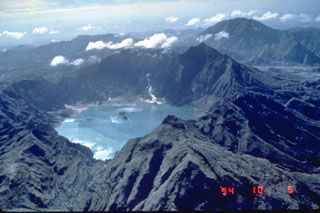Report on Pinatubo (Philippines) — 3 March-9 March 2021
Smithsonian Institution / US Geological Survey
Weekly Volcanic Activity Report, 3 March-9 March 2021
Managing Editor: Sally Sennert.
Please cite this report as:
Global Volcanism Program, 2021. Report on Pinatubo (Philippines) (Sennert, S, ed.). Weekly Volcanic Activity Report, 3 March-9 March 2021. Smithsonian Institution and US Geological Survey.
Pinatubo
Philippines
15.13°N, 120.35°E; summit elev. 1486 m
All times are local (unless otherwise noted)
PHIVOLCS raised the Alert Level for Pinatubo to 1 (on a scale of 0-5) on 4 March noting elevated seismicity with a total of 1,722 earthquakes recorded in two swarms since 20 January. The first swarm was recorded during 20-26 January and was comprised of local M 1-2.5 events that occurred along the Sacobia Lineament fault at depths of 15-28 km. A more persistent swarm followed; it was comprised of local M 0.5-2.8 events at depths of 10-35 km along another fault system, with a few shallower earthquakes occurring at both ends of the swarm. Carbon dioxide flux at Pinatubo Crater lake was 378 tonnes per day in February, within background ranges that topped 1,000 tonnes per day during the last decade. Minor temperature increases were recorded at fumarolic vents.
Geological Summary. Prior to 1991 Pinatubo volcano was a relatively unknown, heavily forested lava dome complex located 100 km NW of Manila with no records of historical eruptions. The 1991 eruption, one of the world's largest of the 20th century, ejected massive amounts of tephra and produced voluminous pyroclastic flows, forming a small, 2.5-km-wide summit caldera whose floor is now covered by a lake. Caldera formation lowered the height of the summit by more than 300 m. Although the eruption caused hundreds of fatalities and major damage with severe social and economic impact, successful monitoring efforts greatly reduced the number of fatalities. Widespread lahars that redistributed products of the 1991 eruption have continued to cause severe disruption. Previous major eruptive periods, interrupted by lengthy quiescent periods, have produced pyroclastic flows and lahars that were even more extensive than in 1991.
Source: Philippine Institute of Volcanology and Seismology (PHIVOLCS)

